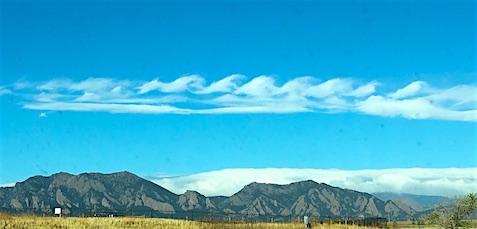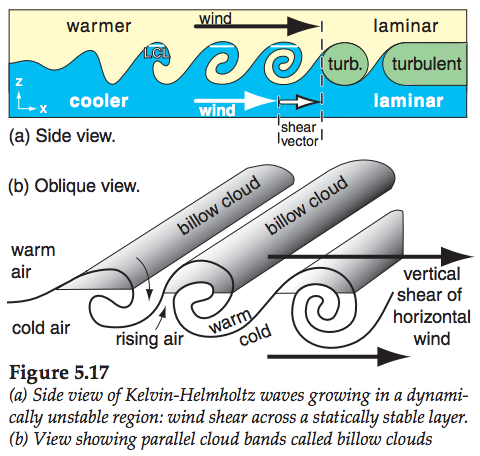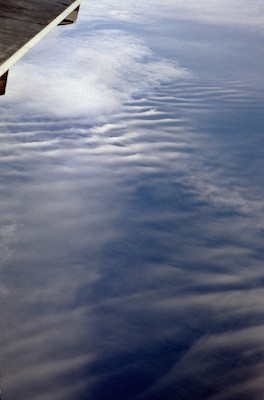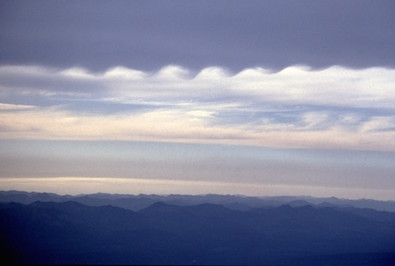Clear-air Turbulence (CAT)
Learning Goal 3e. Describe the characteristics and causes of clear-air turbulence (CAT), and relate them to winds shear & stability
Clear-air Turbulence
When wind-shear turbulence happens outside of (and not near) a thunderstorm cloud, it is called clear-air turbulence (CAT). CAT can happen at any altitude, but is often the most intense where the winds are strongest, such as near the jet stream. The jet stream is a region of fast winds at roughly 6 - 12 km (20,000 to 40,000 feet) altitude — the same altitudes that commercial airliners fly. Regions of CAT are shaped like pancakes: large horizontal extent but relatively thin (1000 - 3000 ft thick). If you encounter CAT, you can often get out of it by climbing or descending to a different altitude.
The figure above shows how it works. Suppose warmer air on top is
moving faster than cooler air below. Namely, there is wind
shear across
a statically stable region. The interface between the two
layers forms
waves in the air (called Kelvin-Helmholtz waves,
or K-H waves
for short) that break and become turbulent. This is CAT. It
probably happens frequently in many parts of the atmosphere, but we
don't usually see it because it happens in clear air.
Sometimes, if
the CAT forms at an altitude where the air is humid (and almost
cloudy), then the updraft portion of the K-H wave can cause enough
lifting to create a thin cloud along the wave crest. If many adjacent
waves have these clouds, then the result looks like closely spaced
strips of clouds called billow clouds(as
shown below). The official name of these clouds is Fluctus, such as Altocumulus Fluctus or Cirrus Fluctus.
This is still called CAT, even though the air is
not perfectly clear, because the CAT is causing or modifying an
otherwise thin passive cloud. (Not like the violently
active thunderstorm clouds.)

Photo by Dr. May Wong, Boulder, Colorado.
For many, many more photos of billow clouds, see Learning Goal 1b Special Clouds - billow clouds.
You can also encounter turbulence in the clear air adjacent to thunderstorms. This is really a type of Convective Turbulence (see Learning Goal 4b), not CAT, although some pilots might report it as CAT because it is in clear air.
Key words: turbulence, clear-air turbulence,
Kelvin-Helmholtz waves, K-H waves, jet stream
Extra info for experts; not needed for this course
Forecasting CAT for Aviation. A MetEd / COMET learning module. (Free, but you need to register.)
World Meteorological Organization Cloud Atlas - Fluctus Clouds .
Image credits: All drawings and photos were created
by Roland Stull., unless indicated otherwise next to the photo.


